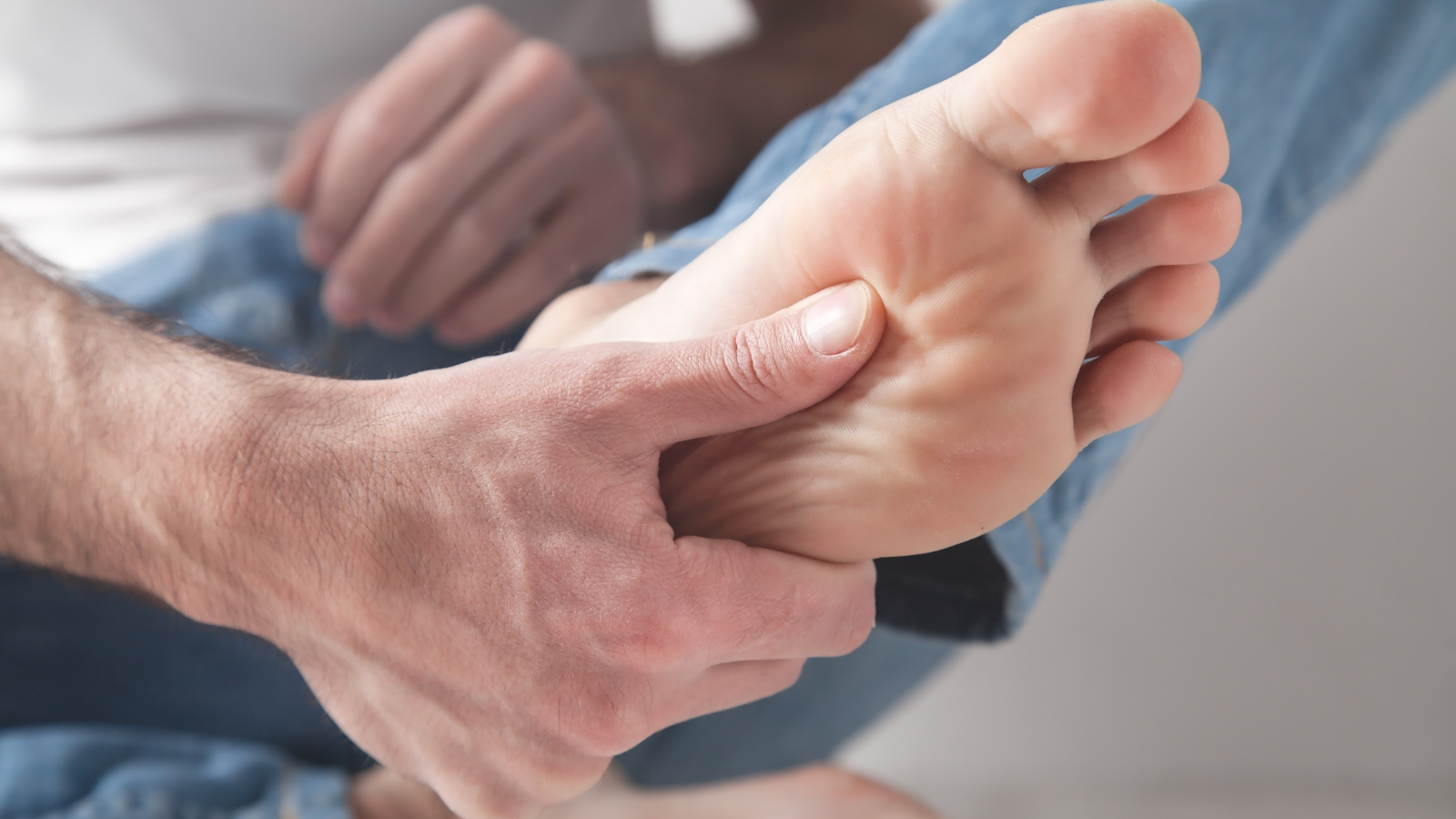If your nails are:
- Damaged
- Ridged
- Thick
- Bruised
- brittle
- Psoriatic
- Fungally infected
- Partially missing
- Discoloured
- need protection while growing
Then Wilde-Pedique toe nail reconstruction is the solution for you!




How is the New Nail Made?
LCN Wilde-Pedique involves the construction of a new nail using a resin gel. After preparing the nail and nail bed, the gel is applied to fill grooves and gaps, then cured (hardened) using harmless UV light. Additional gel layers are applied to create the desired nail shape. Finally, a top seal is applied to complete the process.
The Result
The result is a natural-looking, protective gel nail that is flexible and can be trimmed and filed. The gel is non-porous, allowing for the use of nail varnish and remover without affecting the gel. You can swim and bathe as usual. For those with a fungal nail infection, anti-fungal treatments can be applied around the artificial nail and under its free edge.
Who is it Suitable For?
LCN Wilde-Pedique is suitable for men, women, and teenagers. Its adhesive properties mean that good results can be achieved even on calloused layers of skin or where there is a fifth or more of your own natural nail to reconstruct a new nail. Although the gel will not adhere to skin alone, it can still be constructed to last for a day for special occasions, such as a wedding day. The area must be oil-free, dry, free from any bacterial infection, and there should be no bleeding or weeping. Click here for more information.
Is it Safe?
As a professional podiatry practice, we always take a full medical history and assess for suitability. Our HCPC-registered podiatrists are trained in the application of the gels. The high-quality materials used are hypoallergenic, odourless, anti-fungal, and contain no aggressive primers or chemicals.
How Long Will the Gel Nail Last?
The gel nail typically lasts 4-6 weeks, with some lasting up to 4 months. We do not recommend leaving the nail on for more than 8 weeks. Occasionally, the gel nail may only last for a short time; however, it usually comes off whole and can be reapplied at home using hypoallergenic nail glue. The gel nail is a no-soak-off gel and will grow out together with your natural nail. The more natural nail there is on the nail bed, the longer the gel will last. A deep nail bed is better than a flat or shallow one. Your lifestyle and walking habits will also affect the gel nail's longevity.
How is it Removed?
The gel is no-soak-off and will grow out with your own nail as it grows. It can be trimmed away, or you can revisit us to have it painlessly removed.
What people are saying:
"My visit was for nail reconstruction on my big toe"
"Really impressed with the result"
"Can't wait to wear my sandals on holiday :)"
"Staff are really friendly too...would definitely recommend"
We’ve had amazing results with significant reduction in pain and discomfort and an improvement in the quality of life of many of our patients.
Call us for further information and get ready to show
your feet off this spring and summer!
If you struggle to take the first few steps as you get out of bed then you probably have plantar fasciitis

There are many reasons for heel pain, such as trapped nerves or a fractured heel. However, the majority of heel pain sufferers that we see in our podiatry clinics have plantar fasciitis.
What is plantar fasciitis?
Plantar Fasciitis is inflammation of the plantar fascia, a thick elastic band-type connective tissue on the sole of the foot connecting the heel to the toes. The Plantar Fascia maintains the shape of the arch, helps the foot absorb shock, and propels the foot during walking.
Why do I have plantar fasciitis?
Plantar fasciitis rarely has one clear-cut cause, and in our experience, there are usually several factors that can contribute to the plantar fascia becoming inflamed and painful. From a biomechanical point of view, we often see that people with structurally high arches during non-weight bearing suffer from excessive lowering of the arches during walking (over-pronation), resulting in repetitive over-stretching and tearing of the plantar fascia.
What else can contribute to plantar fasciitis?
There are many factors that can contribute to the development of plantar fasciitis however, the most common causes that we see are:
Poor footwear:
From our years of experience, we know that poor footwear is one of the biggest contributors to Plantar Fasciitis. We see it time and time again, and it is a whole subject in itself! We spend much time on the subject during our heel pain clinics. In short, flat, sloppy, unsupportive footwear with no fastening certainly contributes to heel pain; even good quality footwear such as trainers or new and seemingly comfortable footwear can be a culprit if it is a poor fit. We also see many versions of very unsupportive slippers that can lead to heel pain.
We usually see an influx of plantar fasciitis in April /May, when the weather changes and supportive footwear such as boots and lace–ups is swapped for unsupportive flip-flops, ballet pump-type shoes, or hard flat sandals. This can destabilise and stress the foot, leading to heel pain!
Occupation:
If you spend a lot of time on your feet on hard and flat surfaces, and if you wear unsupportive footwear, you are halfway towards developing heel pain!
Sports and Activity:
Increased speed and impact on the feet during sporting activities can be a factor in those with certain foot types and is also associated with tight Achilles tendons. Added to this unsuitable sports footwear can make you more prone to developing heel pain.
I have heel pain, what do I do now?
There are some simple things that you can start to incorporate into your daily routine:
1. Before you get out of bed do a few ankle circles, lifts and drops and use a long scarf of theraband wrapped under the forefoot and pull the foot towards your body – this stretches your calf and fascia and can make getting out of bed a bit less painful.
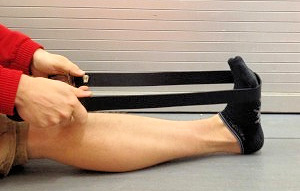
2. Roll your feet slowly over a golf ball or drinks can throughout the day – putting it in the freezer will further reduce discomfort and encourage healing.
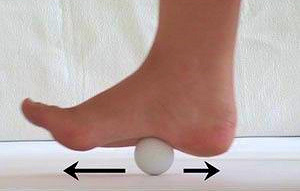
3. Make sure you are avoiding unsupportive footwear – sloppy slippers, flip flops and ballet pumps are going to make your foot worse.
How can we help you?
Our podiatrists love to heel heals!
Here at Romford Podiatry, our experienced podiatrists specialize in digital foot scanning biomechanical assessment, orthotic therapy, expert footwear analysis, and mentoring on a home rehabilitation program; the combined effect of all of these will reduce and cure heel pain.
We also offer shockwave therapy which compliments all the other treatments we offer, this works by breaking down scar tissue, reducing pain levels and stimulating the healing process when the condition is chronic.
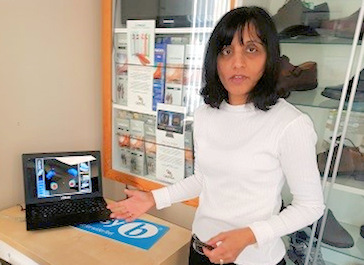
Our mission is to improve the quality of your life!
Please do call us, we are offering a free 10 minute consultation and a free digital foot scan to discuss how we can help you recover from heel pain.
What people are saying about us:
"I visited the practice after suffering severe heel pain. After assessment, treatment and some very good advice; I am now pain free. I made purchases of shoes, slippers and orthotic insoles. Altogether I am extremely pleased with the service and attention that I received."
Dave Hill (Romford)
The good news is that there are some easy things you can do to help prevent any issues from becoming more serious.
Heel pain
It can be debilitating, affecting walking and posture. The most common cause is plantar fasciitis when the ligament that runs under the heel becomes swollen.
Who gets it?
It can affect anyone at any age but is most common in those in their 40s or in athletes.
What can I do myself to help prevent or manage it?
- Wear well-fitting shoes, with good heel cushioning and arch support.
- Avoid walking or exercising on hard ground.
- Rest regularly and try not to walk or run too fast.
- Wear a raised heel (no more than 6-10 mm higher than normal).
Athlete’s foot
A fungal infection that commonly affects dry, flaky areas, like the heel – but can also occur on moist areas of skin, such as between the toes.
Who gets it?
Anyone. Walking barefoot around swimming pools or wearing the same shoes continuously may make you more likely to pick it up.
What can I do myself to help prevent or manage it?
- If it’s affecting dry areas, ask your pharmacist for an anti-fungal cream or spray.
- If it’s in moist areas, wash your feet in cold water then dry them thoroughly – dab, don’t rub.
- Avoid using moisturiser or powders in between the toes.
- Applying surgical spirit can help reduce moisture, but only use on unbroken skin.
- If it is persistent, see a podiatrist.
Bunions
A bony lump on the side of your foot where the big toe excessively angles towards the second toe.
Who gets it?
Although anyone can get a bunion, they tend to be more common in women.
What can I do myself to help prevent or manage it?
- Give your toes room to move by opting for wider shoes.
- If you wear high-heeled shoes, do so in moderation.
- If you want to wear a heel every day, keep heel heights to 4cm or less – and vary your heel heights from day to day.
- Choose shoes with laces, or a strap or buckle over the instep.
- If the bunion becomes inflamed or troublesome, see a podiatrist.
Corns and calluses
Hard, thickened areas of skin, caused in response to rubbing, friction or pressure on the skin.
Who gets it?
They can affect anyone, but may be caused by badly fitting shoes or a biomechanical irregularity in your feet.
What can I do myself to help prevent or manage it?
- Gently rub the area with a pumice stone or foot file when you are in the bath.
- Moisturising cream may help soften the thickened skin.
Ingrowing toenails
Develops when the side of a toenail pierces through the flesh of your toe, making it red, inflamed and painful. It most commonly affects the big toe.
Who gets it?
Anyone, but particularly people who cut their nails incorrectly leaving small spikes of nail behind. Sporty people are more prone because they are likely to get moist, sweaty feet – this can make the skin around the toenails softer and easier for a nail to pierce.
What can I do myself to help prevent or manage it?
- Cut your nails properly – straight across, making sure not to trim them too low at the edge or down the side. Leave the corner of the nail so it’s visible above the skin. Doing it after a bath or shower is helpful, when your nails are softer.
- Avoid moist feet by rotating your shoes and choosing well-fitting socks and shoes made from natural materials.
- At home get your feet out and let the air get to your toes as much as possible!
If you are fed up with any of these problems, book an appointment with us.
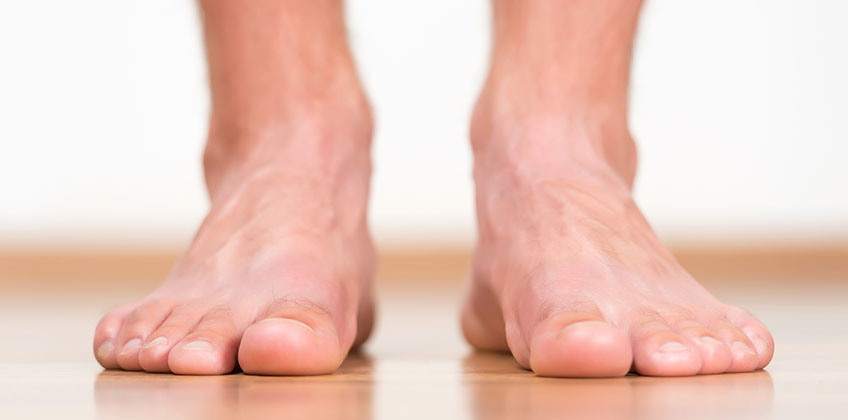
Follow our simple steps to help to keep your feet in tip top shape and reduce your risk of developing any problems.
1. Wash your feet every day
Using warm, soapy water to clean your feet daily helps remove dirt, sweat, and bacteria. It's essential to dry them thoroughly, especially between your toes, to prevent fungal infections like Athlete’s foot. Moist environments can encourage fungal growth, so keeping your feet dry is crucial for maintaining healthy skin.
2. Do regular calf stretches
Incorporate calf stretches into your daily routine to keep your feet supple and prevent tightness that can lead to foot pain and other issues. Stretching your calves helps maintain flexibility in your Achilles tendon and the muscles of your lower legs, reducing strain on your feet. Try standing with your hands against a wall, one foot forward and the other back, and gently push your back heel toward the floor to feel a stretch in your calf.
3. Pay attention to your socks
Wearing well-fitting socks made of breathable materials like cotton or moisture-wicking fabrics can help prevent sweaty feet, which can lead to fungal infections. Change your socks daily to ensure your feet stay dry and fresh. Avoid wearing socks that are too tight or too loose, as they can cause blisters and discomfort.
4. Trim your toenails
Use proper nail clippers to cut your toenails straight across, not too short, and avoid cutting down at the corners to prevent ingrown toenails. Ingrown toenails can be painful and lead to infections if not treated properly. If you have difficulty trimming your nails, consider seeking help from a podiatrist.
5. Keep them moisturised
If your feet are dry, apply a moisturiser before bed to keep the skin soft and prevent cracks. Avoid applying moisturiser between your toes, which can create a moist environment that fosters fungal infections. Look for creams containing urea or lactic acid, which are effective for treating dry skin.
6. Wear the right footwear
Ensuring your shoes fit well is vital for foot health. Ill-fitting shoes can cause blisters, calluses, and other problems. Buy footwear in the afternoon when your feet are at their largest due to natural swelling throughout the day. If you’re unsure of your size, have your feet measured by a professional. Look for shoes with good arch support, a wide toe box, and cushioning.
7. Rotate your shoes
Avoid wearing the same pair of shoes two days in a row to reduce the risk of fungal infections. Rotating your shoes gives them time to air out and prevents moisture buildup. It also helps to extend the life of your shoes and ensures that different parts of your feet get varied support.
8. Vary your heel height
Reserve high heels for special occasions, as regular use can damage your feet. Wearing high heels frequently can lead to issues such as bunions, hammertoes, and back pain. Vary your heel height to distribute pressure more evenly across your feet and reduce the risk of these problems. Opt for lower heels and shoes with good arch support for everyday wear.
9. Check your feet regularly
Give your feet a thorough check every week to spot any potential problems early. Look for signs of dryness, redness, swelling, or abnormalities like corns and calluses. Pay attention to any changes in color or texture, as well as any new or persistent pain. Early detection of issues can prevent them from worsening and requiring more extensive treatment.
10. See a podiatrist
If you experience any foot aches, pains, or concerns, it’s essential to consult a podiatrist. Early intervention can prevent minor issues from becoming major problems. A podiatrist can provide professional advice, diagnose conditions, and recommend appropriate treatments or orthotics to keep your feet healthy.
If you have any concerns aches or pains then you should see a podiatrist, book your appointment with us.
Essential Foot Care Tips for Seniors to Stay Active and Healthy

As we get older, maintaining good foot health becomes increasingly important to stay active and mobile. From around the age of 55, feet can naturally develop problems due to years of daily wear and tear. Additionally, skin loses its elasticity and starts to thin, making it more susceptible to issues. Implementing a good foot care regime can significantly improve foot health and help prevent common problems.
Keep Toenails Short
One of the simplest yet most effective foot care practices is keeping your toenails short. Long toenails can press against the end of your shoes, causing soreness, infections, and even ulcerations. Trim your nails straight across and avoid cutting them too short or down at the corners to prevent ingrown toenails. Regular nail care will keep your feet comfortable and reduce the risk of complications.
Check Your Feet Regularly
Regular foot inspections are crucial for detecting issues early. As feet age, they lose their natural oils, leading to dryness and brittleness, especially in the nails. Check your feet daily, to spot any changes or abnormalities such as cuts, blisters, or redness.
Moisturise Your Feet
Moisturise your feet to keep the skin supple, but avoid applying moisturiser between your toes as this can encourage fungal infections.
Keep Feet Warm
Cold feet can be uncomfortable and lead to reduced circulation. Keep your feet warm by wearing appropriate socks, especially during colder months. Choose warm yet breathable materials, and avoid anything too tight that might restrict circulation or cramp your toes. Keeping your feet warm ensures better blood flow and overall foot health.
Stay Active
Staying active is vital for overall health, including your feet. Regular physical activity tones up muscles, strengthens arches, and stimulates blood circulation. Engage in activities that you enjoy, such as walking, swimming, or gentle aerobics. Always wear suitable footwear during exercise to provide the necessary support and prevent injuries.
Choose Well-Fitting, Supportive Footwear
Footwear plays a critical role in foot health. Shoes that fit well and provide adequate support can prevent many foot problems. Look for shoes with good arch support, a cushioned sole, and enough room to wiggle your toes. Avoid high heels and narrow-toed shoes, as they can cause pressure points and deformities over time. If you have specific foot issues, book an appointment as we can provide personalised footwear recommendations.
By incorporating these simple yet effective foot care practices into your daily routine, you can maintain healthy feet and stay active as you age. Regular nail trimming, daily foot inspections,moisturing, keeping your feet warm, staying active, and wearing well-fitting footwear are essential steps to prevent common foot problems and ensure overall foot health. Remember, taking care of your feet is crucial for maintaining mobility and enjoying an active lifestyle well into your senior years.
Remember, foot pain is not normal; if you are experiencing foot pain or worried about anything. Get in contact.
Are your children wearing the right size, type & style of shoe?
Children's feet undergo significant changes as they grow, reflecting the rapid development and physical transformations occurring throughout childhood. From birth to adolescence, a child's feet grow quickly, with the most rapid growth occurring in the first few years of life.
During infancy and toddlerhood, the bones in the feet are still forming and are primarily composed of soft, flexible cartilage. As children begin to walk and explore their environment, their feet gradually strengthen and adapt to support their body weight and movement.
By the time they reach school age, their feet continue to grow and develop, requiring regular assessments to ensure they wear appropriately sized and supportive footwear. This period of growth is crucial, as improper footwear can lead to developmental issues and discomfort.
During the teenage years, the feet undergo further changes, often growing in size rapidly and stabilising as they approach adulthood. Regular monitoring and proper foot care are essential throughout these stages to ensure healthy foot development and to prevent long-term problems.
Toddler shoes 
- Once your baby starts to walk unaided, typically around 12 to 18 months, it's time to consider proper footwear. Shoes at this stage should be lightweight, flexible, and made of breathable materials to allow natural foot movement and growth.
- When your child begins to walk outdoors, they will need shoes that provide protection. These should have a soft sole with good grip to prevent slips and falls, and they should be well-fitted to avoid restricting natural foot development.
- Children’s feet grow quickly, so it’s essential to have their feet measured regularly by a trained shoe fitter, ideally every 6 to 8 weeks in the first few years.
Children’s shoes
How many pairs of shoes does a child need?

- Everyday Shoes:
- 1 pair of well-fitting, comfortable shoes are essential for daily wear. These should provide good support and be suitable for a variety of activities, including running, playing, and walking.
- School Shoes:
- 1 pair of school shoes that are sturdy and appropriate for the school environment. Ensure they are comfortable and provide adequate support for all-day wear.
- Outdoor/Play Shoes:
- 1 pair of durable, play-specific shoes, such as trainers. These should be designed to handle rough play and outdoor activities.
- Seasonal Footwear:
- 1 pair of sandals for warm weather, which should be comfortable and provide some level of foot protection.
- 1 pair of waterproof boots for wet or snowy conditions, keeping their feet dry and warm.
- Sports Shoes:
- 1 pair of sports-specific shoes, such as running shoes or soccer cleats, depending on the child’s interests and activities. Make sure these shoes are appropriate for the specific sport or activity.
- Smart Shoes:
- 1 pair of dress shoes for formal occasions or special events. These should be comfortable enough to wear for a few hours at a time.
Additional Tips:
- Regularly Check Fit: Children’s feet grow quickly, so it’s important to check their shoe size every few months.
- Rotate Shoes: Avoid wearing the same pair of shoes every day to give them time to air out and reduce the risk of fungal infections.
- Consider the Climate: Adjust the number and type of shoes based on the weather and activities in your area.
Teenage shoes
Advising a teenager on which shoes to wear can be a bit challenging, especially since teenagers often prioritise fashion and peer trends over comfort and functionality. Here are some tips on how to guide them towards making good footwear choices.

1. Understand Their Style Preferences
- Listen First: Ask your teenager about their style preferences and favourite brands. Understanding what they like can help you find shoes that meet both their style and functional needs.
- Find a Balance: Look for shoes that are stylish but also provide the necessary support and comfort.
2. Highlight the Importance of Comfort and Support
- Explain Consequences: Discuss how wearing the wrong type of shoes can lead to foot problems, discomfort, and even affect posture and overall health.
- Show Options: Introduce them to stylish brands that also focus on comfort and support. Many athletic and casual shoe brands now offer trendy designs.
3. Consider Their Activities
- Daily Wear: Recommend versatile shoes that are comfortable for daily wear, such as well-cushioned sneakers or casual shoes.
- Sports and Exercise: Emphasise the importance of wearing sport-specific shoes for activities like running, basketball, or gym workouts. These shoes are designed to provide the necessary support and reduce the risk of injury.
- Special Occasions: Suggest having a pair of dress shoes for formal events. Look for styles that offer both elegance and comfort.
4. Teach Proper Shoe Maintenance
- Rotation: Encourage them to rotate between different pairs of shoes to allow each pair to air out and maintain their shape.
- Cleaning: Show them how to properly clean and care for their shoes to extend their lifespan.
5. Prioritise Fit
- Proper Measurement: Ensure they get their feet measured regularly, as teens can still experience foot growth. A properly fitting shoe is crucial for comfort and foot health. Take a look at our shoe fitting guide.
- Try Before Buying: Advise them to always try on shoes and walk around in them to ensure they fit well and feel comfortable.
6. Encourage Practical Choices
- Seasonal Footwear: Suggest appropriate footwear for different seasons, such as waterproof boots for winter and breathable shoes for summer.
- Heel Height: For those interested in fashion, suggest limiting the use of high heels to special occasions and opting for lower, more supportive heels for regular wear.
7. Set a Good Example
- Lead by Example: Wear comfortable and appropriate shoes yourself to set a positive example.
- Be Supportive: Offer to go shoe shopping with them to provide guidance and support in making good choices.
Proper footwear is essential for children’s foot health at every stage of their development. Regular checks and consultations with professionals can prevent minor issues from becoming serious problems. If you have concerns about your children's feet or footwear, don't hesitate to seek advice. Taking these steps will help ensure your children’s feet stay healthy and well-supported as they grow.
If you are concerned about your child's foot health, get in touch.
Do You Have Difficulty Shopping for Shoes? Here’s How to Get the Perfect Fit 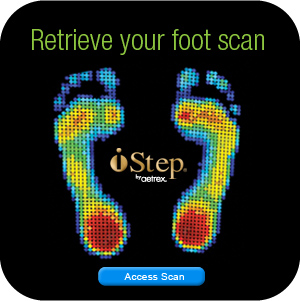
Shoe shopping can be a daunting task, especially if you struggle to find the right fit. According to a study conducted by the College of Podiatry, out of 2,000 adults surveyed, one-third of men and nearly half of women admitted to purchasing shoes that didn't exactly fit. While it might not seem like a huge deal if a pair of heels feels a smidge too tight, improperly fitting shoes can actually have several negative health effects. Hammertoe deformities, bunion growth, and consistent foot pain are common consequences, but poorly fitting shoes can also contribute to issues like headaches, knee, hip, and back pain.
The Importance of Properly Fitting Shoes
As a podiatrist who also supplies and fits shoes, I've come to realise that the only way to purchase a comfortable pair of shoes that will suit your individual needs is to have the shoes fitted to your feet. It's essential to try different sizes and different width fittings until you find the correct and most comfortable shoe for you. Variations in size with different brands mean that a certain size in one brand may not be the same in another.
Shoes are made on a three-dimensional wooden or plastic mold known as a shoe last. The last used during shoe assembly can affect the overall fit of a shoe. Even though all lasts include dimensions such as heel width, instep height, forefoot width, and toe box depth, some lasts feature a deeper toe box or a wider forefoot, while others might offer a narrower heel. This variability means it's worth taking the time to choose and try the shoes in shops.
Tips for Finding the Perfect Fit
Have Your Feet Measured: Just as you wouldn't buy shoes for your child without measuring their feet, it's important for adults to have their feet measured too. Accurate measurements can prevent many foot-related issues.
Try Before You Buy
Always try shoes on before purchasing. Walk around the store with both shoes on and wear the hosiery that you would normally wear with the shoes you're trying to buy. This ensures you get a realistic sense of how the shoes will feel during everyday use.
Consider Different Brands and Styles
Don't stick to one brand or style. Different brands use different lasts, which can significantly affect the fit. A size 8 in one brand may feel completely different in another.
Check for Width Fittings
Many people focus only on the length of the shoe, but width is equally important. Look for shoes that offer various width fittings to ensure a snug but comfortable fit.
Use a Foot Scanning Service
Some clinics, like ours in Basildon and Romford, offer foot scanning services. These scans provide valuable information about your arch type, pressure patterns, and exact size—all important factors when choosing the right shoe.
Seek Professional Advice
If you're unsure about what type of shoe is best for you, consult with a podiatrist or a footwear consultant. They can provide personalized recommendations based on your specific foot structure and needs.
Why It’s Worth the Effort
Investing time and effort into finding the right pair of shoes can save you from a host of foot problems. Properly fitting shoes provide the necessary support and comfort, preventing conditions such as hammertoes, bunions, and chronic pain. Moreover, wearing the right shoes can improve your posture and alleviate strain on your knees, hips, and back.
If you require shoe fitting advice or would like to try shoes that are supplied at the Basildon and Romford Surgeries, call us. Our Footwear Consultants, Sandra and Simone, will be happy to assist you, book your appointment. With our foot scanning service, you can understand your foot structure comprehensively, helping you make informed decisions when purchasing shoes.
Remember, your feet carry you through life. Taking the time to find shoes that fit well is a crucial step in maintaining overall health and comfort.
To Book your Footscan call Basildon 01268 553653 or Romford 01708 728498
Are you walking, hiking, or running?
My patients are really pleased with Gehwol
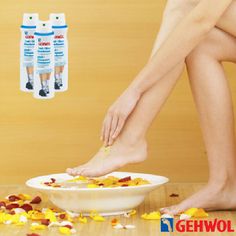
a refreshing and caring cream for tired and sore feet that really take a beating.
- Gehwol Foot cream has been known since 1882
- The cream prevents aching feet, blisters, and soreness
- The anti-inflammatory effect prevents infections, brings the perspiration back to a normal level, and eliminates foot odour, and other side effects of excessive perspiration.
- Gehwol foot cream strengthens the skin and leaves it more resilient.
- Gehwol contains chloroxylenol and oil of thyme which deodorizes, disinfect, and help to protect from athletes’ foot.
- Gehwol contains Camphor which stimulates the blood flow
- Gehwol contains menthol which refreshes while the base ointment of medicated soap, Vaseline, lanolin and talcum protect the skin against wounds and blisters
We are stockits of Gehwol Foot cream.
Latest Tips
- Why Heel Pain Is So Common
- At FootScan appointment at Essex Footcare
- The Complete Guide to Footwear: Choosing the Right Shoes for Every Occasion
- How is Your Socks Life?
- What is Swift Microwave Therapy?
- Is your ingrown nail a right pain the foot ?
- Chair exercises
- Would You Like Your Toe Nails To Feel & Look Great?
- Do you have painful heels in the Morning?
- Do you suffer with any one of these 5 common foot conditions?
What People Say
-
The shoes have made my life so much easier
I am extremely pleased with the kindness and service that I was...
-
Happy Comfortable Feet
I go to Sushila Patel as I like happy comfortable feet. I have been...
